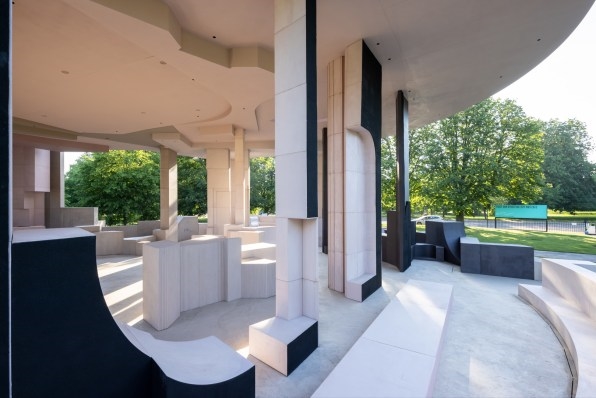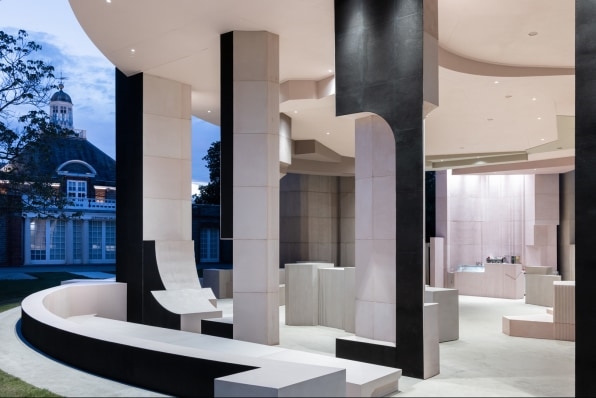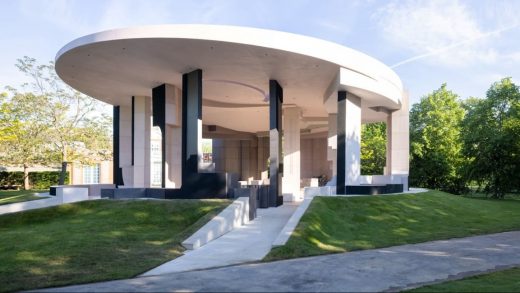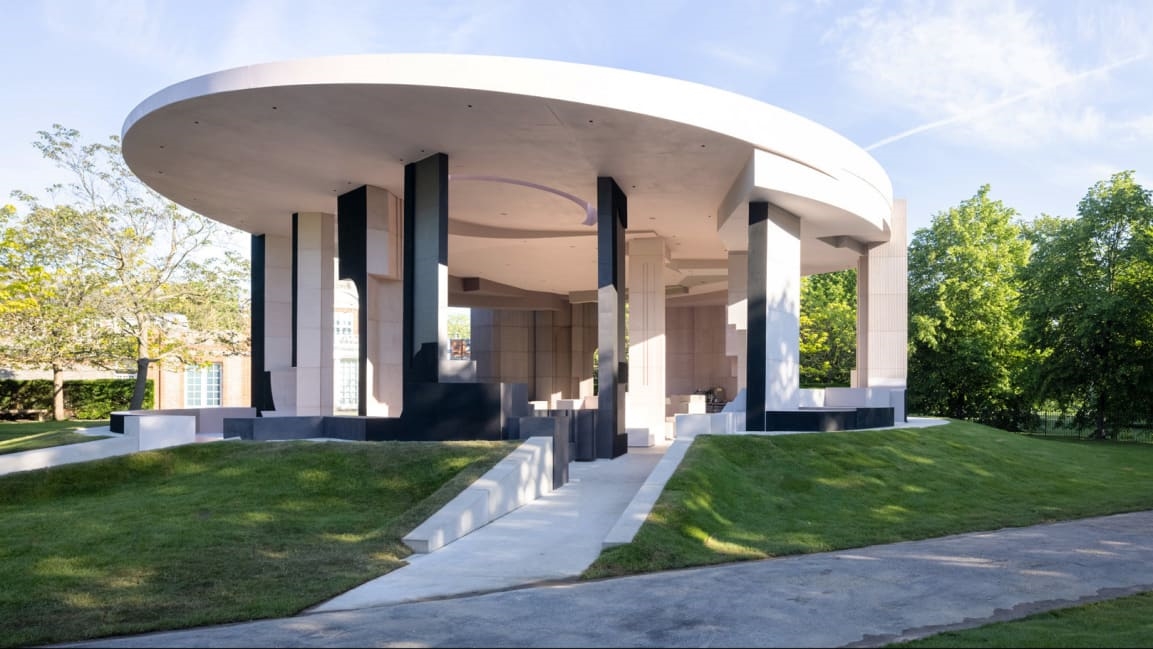This gorgeous pavilion is made almost entirely of waste
The new Serpentine Pavilion, now open in London’s Kensington Gardens, is a high-profile piece of temporary architecture with a few big ideas hidden inside its walls—and beyond its site.
Commissioned annually by the Serpentine Galleries, the pavilion features the work of an international architect who is pushing the edges of civic architecture. This year’s iteration contains bold new thinking about construction and the importance of public space.
The more concrete of these ideas is the construction material used to build it: recycled materials that hint at a more sustainable way of building. Also hidden inside are the abstracted influences of a diverse array of gathering spaces from across London, making the subtle argument that the city’s range of communities and spaces are the source of its cultural production. To make that point even clearer, pieces of the pavilion are for the first time being set up in spaces throughout the city for more engaged use. The pavilion aims to reflect and serve communities beyond the grounds of an elite art gallery.

The pavilion was designed by Johannesburg-based practice Counterspace, under the direction of Sumayya Vally, 31, the youngest architect to design a pavilion in the Serpentine Pavilion’s 20-year history. With past pavilions designed by notable architects such as Zaha Hadid, Herzog and de Meuron, and Frida Escobedo, being selected to design the space can both confirm and elevate an architect’s status.
A circular roof covers the pavilion’s multilayered interior space, with nooks and gathering spaces surrounded by a ringed colonnade reminiscent of classical architecture, but with a post-modern flair of curve, chunkiness, and void. Mixing a salon that could have been used by ancient Greek gods and the bedroom from 2001: A Space Odyssey, the pavilion evokes both the past and the future.
The project was built to be carbon negative, sequestering more carbon dioxide than was emitted to produce and construct it, and uses primarily recycled or repurposed materials for its construction. The structure is provided by reclaimed steel from the yard of contractor Stage One, which also fabricated the pavilion off-site. Sustainably sourced plywood and cork reclaimed from the winemaking industry make up the walls and textures of the space, and it’s weatherproofed with a micro-cement derived from lime and waste from marble production.
AECOM, the engineer of the pavilion, explains that early versions of the design explored using unfired bricks made from reclaimed construction waste and elements made out of the mycelium of fungus, but these approaches were deemed inadequate for the pavilion’s complex geometries.
In her description of the pavilion, Vally explains that the design was informed by a deep study of cultural and gathering spaces throughout the city. The shape of the interior of the pavilion was formed by “adding, abstracting, superimposing, and splicing” these other spaces, including some of the first mosques built in the city, a famous cooperative bookshop that was forced to close in 2012, sound system dancehalls in Brixton, and the Ramadan meal a local mosque held in the street to support survivors of the 2017 Grenfell Tower fire.

“To think about the ways that people have gathered over time in London was very important,” Vally said in a recent discussion with Hans Ulrich Obrist, the Serpentine Galleries’ artistic director. “Architecture affirms a sense of belonging. It teaches us what we deserve, what we should expect of the world. How architecture treats us tells us so much about who we are, and it also affirms our position in the world.” Vally was unavailable for an interview.
Vally founded Counterspace in 2015, and past projects include designs, research, and installations, including the design of a mosque that had taken over the space of a Dutch Reformed church in a Johannesburg suburb and an archive of Ponte Tower, a circular residential tower built in Johannesburg in 1975 that embodies tumultuous years in the city’s apartheid and post-apartheid evolution.
Originally scheduled to open last summer but delayed due to pandemic complications and restrictions, the pavilion’s concept has evolved during its two-year gestation and now includes several community-focused elements that aim to extend its impact. The pavilion itself is being spread throughout the city, with four fragments of the structure being placed around London as a way of injecting new public and gathering spaces within community-focused cultural organizations.
One is a reading podium for New Beacon Books, one of London’s first Black publishers. Another is a movable seating and stage combination for a multipurpose venue in Notting Hill that hosts an annual Caribbean style Carnival. Vally calls these fragments “seeds for new collaborations between the Serpentine and these partner institutions. . . . For me, it’s very important that they come to represent and they come to be something that will extend beyond the life of the pavilion.”
The project has also instigated the launch of an annual fellowship program that will support up to 10 young artists with grants of at least £10,000 (about $14,000) for works in spatial and community practice. Recipients will be announced in July.
The conspicuous downside of this year’s pavilion is its significant concrete foundation—about 3,300 cubic feet of carbon-intensive material that will likely be crushed and landfilled after the pavilion’s four-month run. AECOM described the concrete as an unfortunate but necessary part of the structure.
The pavilion will be open at the Serpentine Gallery until October 17. Like many previous pavilions, it will then take on a new life elsewhere, after being purchased for reuse by an Austrian spa owner, which will likely install it as part of a $350 million spa facility planned in Manchester. Though this luxurious future strays from the pavilion’s community-centric design, what happens to the main structure may be less important than what the fragments scattered throughout the city are able to provide in the years to come.
(46)



